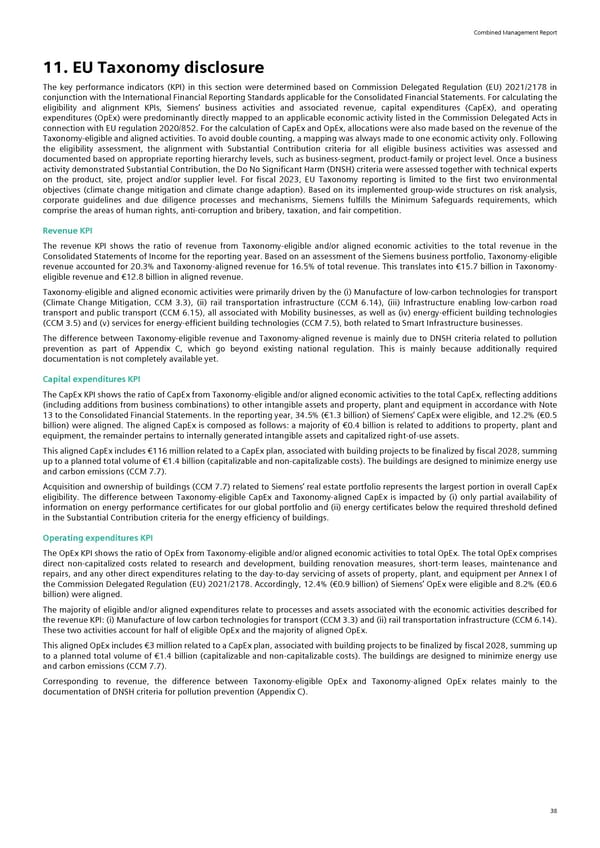Combined Management Report 11. EU Taxonomy disclosure The key performance indicators (KPI) in this section were determined based on Commission Delegated Regulation (EU) 2021/2178 in conjunction with the International Financial Reporting Standards applicable for the Consolidated Financial Statements. For calculating the eligibility and alignment KPIs, Siemens’ business activities and associated revenue, capital expenditures (CapEx), and operating expenditures (OpEx) were predominantly directly mapped to an applicable economic activity listed in the Commission Delegated Acts in connection with EU regulation 2020/852. For the calculation of CapEx and OpEx, allocations were also made based on the revenue of the Taxonomy-eligible and aligned activities. To avoid double counting, a mapping was always made to one economic activity only. Following the eligibility assessment, the alignment with Substantial Contribution criteria for all eligible business activities was assessed and documented based on appropriate reporting hierarchy levels, such as business-segment, product-family or project level. Once a business activity demonstrated Substantial Contribution, the Do No Significant Harm (DNSH) criteria were assessed together with technical experts on the product, site, project and/or supplier level. For fiscal 2023, EU Taxonomy reporting is limited to the first two environmental objectives (climate change mitigation and climate change adaption). Based on its implemented group-wide structures on risk analysis, corporate guidelines and due diligence processes and mechanisms, Siemens fulfills the Minimum Safeguards requirements, which comprise the areas of human rights, anti-corruption and bribery, taxation, and fair competition. Revenue KPI The revenue KPI shows the ratio of revenue from Taxonomy-eligible and/or aligned economic activities to the total revenue in the Consolidated Statements of Income for the reporting year. Based on an assessment of the Siemens business portfolio, Taxonomy-eligible revenue accounted for 20.3% and Taxonomy-aligned revenue for 16.5% of total revenue. This translates into €15.7 billion in Taxonomy- eligible revenue and €12.8 billion in aligned revenue. Taxonomy-eligible and aligned economic activities were primarily driven by the (i) Manufacture of low-carbon technologies for transport (Climate Change Mitigation, CCM 3.3), (ii) rail transportation infrastructure (CCM 6.14), (iii) Infrastructure enabling low-carbon road transport and public transport (CCM 6.15), all associated with Mobility businesses, as well as (iv) energy-efficient building technologies (CCM 3.5) and (v) services for energy-efficient building technologies (CCM 7.5), both related to Smart Infrastructure businesses. The difference between Taxonomy-eligible revenue and Taxonomy-aligned revenue is mainly due to DNSH criteria related to pollution prevention as part of Appendix C, which go beyond existing national regulation. This is mainly because additionally required documentation is not completely available yet. Capital expenditures KPI The CapEx KPI shows the ratio of CapEx from Taxonomy-eligible and/or aligned economic activities to the total CapEx, reflecting additions (including additions from business combinations) to other intangible assets and property, plant and equipment in accordance with Note 13 to the Consolidated Financial Statements. In the reporting year, 34.5% (€1.3 billion) of Siemens’ CapEx were eligible, and 12.2% (€0.5 billion) were aligned. The aligned CapEx is composed as follows: a majority of €0.4 billion is related to additions to property, plant and equipment, the remainder pertains to internally generated intangible assets and capitalized right-of-use assets. This aligned CapEx includes €116 million related to a CapEx plan, associated with building projects to be finalized by fiscal 2028, summing up to a planned total volume of €1.4 billion (capitalizable and non-capitalizable costs). The buildings are designed to minimize energy use and carbon emissions (CCM 7.7). Acquisition and ownership of buildings (CCM 7.7) related to Siemens’ real estate portfolio represents the largest portion in overall CapEx eligibility. The difference between Taxonomy-eligible CapEx and Taxonomy-aligned CapEx is impacted by (i) only partial availability of information on energy performance certificates for our global portfolio and (ii) energy certificates below the required threshold defined in the Substantial Contribution criteria for the energy efficiency of buildings. Operating expenditures KPI The OpEx KPI shows the ratio of OpEx from Taxonomy-eligible and/or aligned economic activities to total OpEx. The total OpEx comprises direct non-capitalized costs related to research and development, building renovation measures, short-term leases, maintenance and repairs, and any other direct expenditures relating to the day-to-day servicing of assets of property, plant, and equipment per Annex I of the Commission Delegated Regulation (EU) 2021/2178. Accordingly, 12.4% (€0.9 billion) of Siemens’ OpEx were eligible and 8.2% (€0.6 billion) were aligned. The majority of eligible and/or aligned expenditures relate to processes and assets associated with the economic activities described for the revenue KPI: (i) Manufacture of low carbon technologies for transport (CCM 3.3) and (ii) rail transportation infrastructure (CCM 6.14). These two activities account for half of eligible OpEx and the majority of aligned OpEx. This aligned OpEx includes €3 million related to a CapEx plan, associated with building projects to be finalized by fiscal 2028, summing up to a planned total volume of €1.4 billion (capitalizable and non-capitalizable costs). The buildings are designed to minimize energy use and carbon emissions (CCM 7.7). Corresponding to revenue, the difference between Taxonomy-eligible OpEx and Taxonomy-aligned OpEx relates mainly to the documentation of DNSH criteria for pollution prevention (Appendix C). 38
 Siemens Report FY2023 Page 39 Page 41
Siemens Report FY2023 Page 39 Page 41